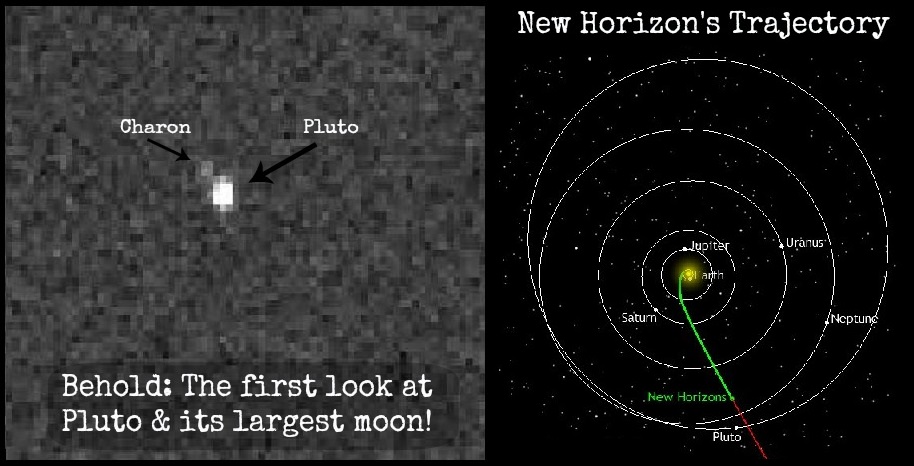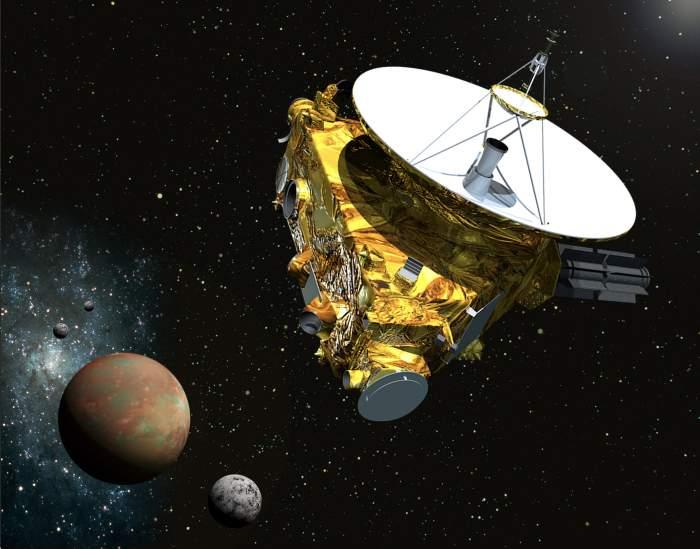

To be clear, I know these images leave something to be desired when you first look at them, but one must take a moment to consider the fact that here, we are looking at the first non-Hubble image of everyone’s favorite dwarf-planet, Pluto (and its largest moon). The image was taken by the New Horizons Spacecraft, which is currently inching its way to Pluto, which will eventually give us the first up-close look at the Plutonian system.
At the time when the image was taken, the spacecraft was merely 550 million miles (900 million kilometers) away from Pluto, which may sound like a lot, but keep in mind that Pluto is located more than 3 BILLION miles from Earth; so, New Horizons has basically completed 80% of it’s journey. Pluto’s distance from Earth can vary quite a bit since it has an insanely elliptical orbit, which occasionally takes the dwarf planet closer to Earth than Neptune.
In the image, Charon (Pluto’s largest moon) can be seen above and to the left of Pluto. It may look like a grainy piece of crap picture (and I guess it kind of is), but the excitement is all about the anticipation. I mean, LOOK! After trekking through our solar system for a little over 7 years, the spacecraft can finally resolve the system, which is a feat in and of itself, as Pluto itself is only 1,500 miles across (2300km), while Charon is merely 720 miles (1,200 km) across. It won’t be long at all now (in about a year and a half) when New Horizons arrives at Pluto (something I, and I’m sure several of you as well, have been awaiting for with baited breath).
New Horizons
Now, for a little bit of history, “New Horizons” was launched on January 19, 2006 to explore the dwarf planet, Pluto and its 5 known moons. It flew by Mars on April 7, 2006; the orbit of Jupiter (where the spacecraft received a sling-shot like boost using the planet’s gravitational pull) on February 28, 2007; the orbit of Saturn on June 8, 2008; and the orbit of Uranus on March 18, 2011. Since July of 2013, its distance from Pluto is less than 5.94 AU (about 25.64 AU from Earth). From this distance, it takes more than 3.55 hours to send commands to the spacecraft. (That is just one way communication.)

While en route to the formerly classified “planet” (sorry guys, Pluto is *not* a (major) planet anymore), the spacecraft made a distant flyby of a relatively unknown small asteroid named 132524 APL. Whereby, it came within 63,500 miles (102,000 kilometers) of the asteroid’s surface.
Due to safety concerns, the higher-resolution LORRI camera couldn’t open its door until late August, to guard against accidental Sun pointing, but the asteroid was tracked successfully for 2 days using instruments that were on board.
After thoroughly exploring Pluto and its icy moon, Charon, (and hopefully procuring hundreds of high resolution images of the never before seen objects; the craft will head towards the Kuiper belt. Upon arrival, since maneuvering capability is limited, this phase of the mission is contingent on finding suitable KBOs (Kuiper belt objects) close to New Horizon’s flight path, ruling out any possibility for a planned flyby of Eris, a trans-Neptunium object comparable in size to Pluto.
Recent speculation has suggested that Charon may have water plumes erupting from its surface — just another reason to get pumped for 2015!
Since we’re on the subject, Pluto is pretty cool, but you would NOT want to live, or even visit, there. Here is our list of the worst places to live in our solar system